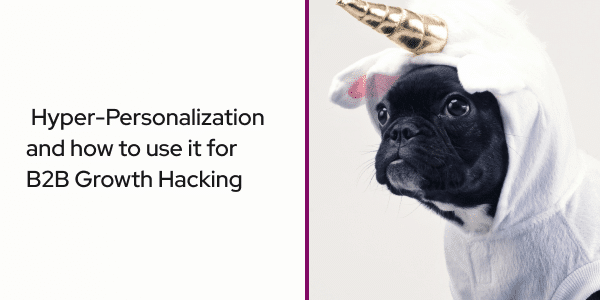What is all the Hype About Hyper-personalization and how to use it for B2B Growth Hacking
What sustains any business is the number of customers it has; this is the main reason the marketing team is always going about attracting and converting new customers. You need customers and many of them to grow your business.
A term that you may have heard often while struggling to grow your business is “growth hacking.” But, have you taken out the time to discover what growth hacking is really and why it may be different from other marketing strategies you have been implementing?
Growth hacking refers to the specific set of marketing practices that you need to ensure that your business reaches the top of whatever niche you may belong to and also maximize revenue. It involves driving business growth, which ultimately means the strategies you must put in place to attract more customers and drive more sales.
While you go about trying to attract more customers, you must also ensure that these customers will remain loyal to your brand, hence growth hacking strategies do not only ensure that you attract more customers, they enable you to elongate customer lifetime value. For your B2B growth hacking, you want quality customers, and that requires a combination of content optimization and hyper-personalization.
Content optimization
Content optimization refers to the process you need to write your content so that it reaches the largest possible audience. To optimize your content, you must ensure that you make use of the necessary keywords, add meta and title tags, as well as include relevant links.
While you need keywords, content optimization is not about creating content for keywords; there is the need to have natural content; it must also have grammatically correct style and voice. If you overstuff your content with keywords, you will have problems with the content quality and your target audience eventually.
While content means a lot, it’s not enough that you just go on pushing out content. How do you ensure that your content is receiving attention from your B2B target audience? What must you do to create content that will enable your B2B growth hacking?
Hyper-personalization
Not quite long ago, content personalization was seen as a novelty. This has dramatically changed, as customers believe you must talk to them as persons and not as numbers; marketers have also realized the benefits of sending personalized messages to their customers. This means that the era of hyper-personalization and not just personalization has arrived.
According to a study, 91% of consumers say they will most likely shop with any brand that provides offers and recommendations that are relevant to their needs. While this may look like a B2C setting, the B2B brands must consider this as an urgent need to personalize their content to brands they deal with.
Another study reveals that 75% of marketers have seen the need to initiate dynamic and personalized content across channels. What this means is that B2B brands must understand the need to personalize their customers’ touchpoints for effective growth hacking.
In a recent expert panel held by CXBuzz on Hyper-Personalization and its Effects on CX, Jenn McMillen, Chief Accelerant at Incendio, describes hyper-personalization as 1-to-1 marketing that can tremendously improve customer experience. “It starts with collecting zero- and first-party data to lay the foundation of personalization and relevancy. That’s table stakes these days and the contract every company needs to make with its constituents,” says McMillen.
Marketers are extensively using their email marketing platforms to ensure the segmentation of customers for the purpose of targeting specific groups based on demographics and behavioral data. While this may seem not to be B2B marketing, since B2B marketing targets brands, the truth is that you must target the human beings in any type of organization.
Having insight into the behavior of the CEO or the C-suite of any B2B brand determines how you can personalize your messages and based on behavioral segmentation, you can easily identify what they as your customers actually need and how to interact with them.
These are some ways you may need to segment your B2B customers based on their behaviors as regards your business:
- How they react to your product, brand, or service.
- What use do they make of your product or service?
- What is their understanding of your brand or products?
- What is their purchasing history?
- Do they need your product all year round, or for only special occasions?
When you have all the necessary information you need to segment your customers behaviorally, you can use it to personalize your B2B sales funnel according to what they need. That is what hyper-personalization is all about; it allows you to use the information you have about your customers and leverage technological developments to optimize your content in a way your customers will understand and realize you are talking to them as individuals and not as numbers you invariably picked from one source or the other.
There has been personalized marketing, but B2B growth hacking needs more than just ordinary personalization to take B2B marketing up to the next notch; you need hyper-personalization. All the details and data points you need can only be made possible by hyper-personalization.
With hyper-personalization, your B2B customers’ data will be completely analyzed, and you will have the veritable insight you require for your customers’ pain points.
Wrapping up
Nothing wraps up the hype about hyper-personalization and how to use it for B2B growth hacking better than how Kevin Leonor, Customer Success Manager at Zoom puts it at the expert panel held by CXBuzz on Hyper-Personalization and its Effects on CX, “Exclusivity. Instant Ownership.”
This boils down to the fact that by hyper-personalizing things, you ensure the celebration of the user’s uniqueness. By placing B2B brands in hyper-segmented groups, you are creating a sense of exclusivity and belongingness that sets the B2B brand different from the group, notwithstanding that they are similar.
You have created a comfortable balance.






